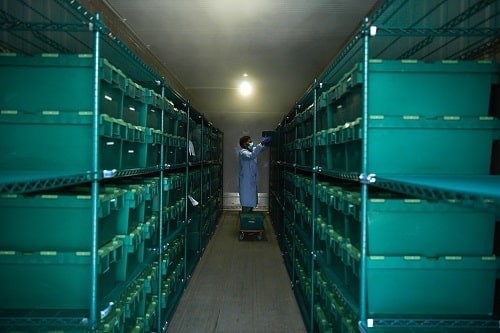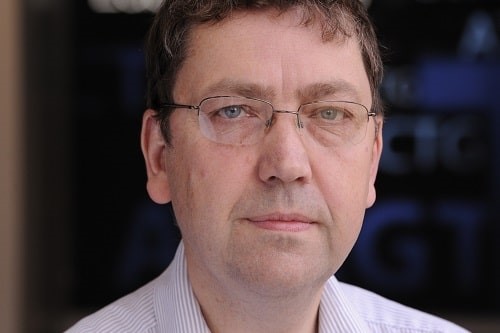Since late March 2020, the Wellcome Sanger Institute has sequenced the genetic code of the Covid-19 virus as part of the COVID-19 Genomics UK (COG-UK) initiative. The data generated is helping public health bodies to track the spread of the virus and save lives.
Features
Sequencing the Covid genome safely
Safety Management spoke to Simon Rice, Head of Campus Health & Safety at the Wellcome Genome Campus, where the Sanger Institute is based, to find out about the safety dimension of the work. When it comes to handling the coronavirus, how do you keep your laboratory staff safe?
What is virus sequencing?
The work is the largest operation of its kind in the world to analyse the genetic code of the virus and track how it’s changing. As of the 8 February, Sanger has sequenced 136,383 coronavirus genomes and processed a total of 17 million samples. If you’ve taken a Covid PCR test, it’s quite possible your swab will end up here. The operation runs seven days a week.
 Covid test samples in frozen storage. Positive samples will be picked out to be sequenced.Photograph: Wellcome Sanger Institute
Covid test samples in frozen storage. Positive samples will be picked out to be sequenced.Photograph: Wellcome Sanger Institute
Sequencing of the SARS-CoV-2 virus allows scientists to track its genomic mutations. Mutations occur naturally as the virus replicates in our bodies, though most do not affect its functions. Mutations that affect the virus’s spike protein, which it uses to bind to and enter human cells, are of particular interest to researchers. It’s here at Sanger that the Kent B.1.1.7 variant was identified. “Surge testing that’s been happening in different places of the country is a consequence of us knowing and telling the government there are cases associated with those areas,” says Simon.
The campus is vast, with labs and other buildings dotted across its 130 acres. Around 450 people work here, but in pre-Covid times there would be 2,500 people. Simon’s team looks after the laboratories on the campus, as well as the health and safety education and engagement work with the campus community.
Protecting against the virus
Coronavirus is classified by the HSE as a hazard group 3 organism, one level down from Ebola which is hazard group 4 (the highest level). “An organism will receive a hazard category based on a system of the likelihood that it will cause disease by infection or toxicity in humans; how likely it is that the infection would spread to the community; and whether we have the capability to treat any infections,” Simon says. “Currently the virus samples are arriving inactivated, reducing the risk to laboratory staff.”
As a result of that hazard group rating, a different level of protection is required, affecting everything from the laboratory’s design, to PPE and processes. The laboratory’s ventilation system is designed to change the air 15–20 times per hour. Scientists work with samples in Microbiological Safety Cabinets, which also have air filters. “The cabinets pull in laboratory air and filters it with very high efficiency particulate filters. It’s like a box that’s open at the front, a large set of fans on top and the air is circulating and what that does is prevent any aerosols that are generated by the work from coming into the contact with the operator.”
“With this virus the risk is transmission through the air and inhaling the virus particles,” says Simon. “The virus can also be picked up from a contaminated surface and on touching your face inhaled into the respiratory system. If you can minimise these two transmission routes you can minimise the transmission between different people. Hence the UK Government slogan Hands – Face – Space.”
Lab workers wear disposable gloves, which are changed regularly, and a ‘Howie’ lab coat – with buttons done up on one side rather than the front.
Robots lend a hand
Before sequencing, samples need to get to the lab. Every day, the samples arrive from Covid PCR testing centres around Britain containing the precious RNA of the virus. “RNA is very labile which means it degenerates very easily at room temperature. One of the ways to protect against that is to freeze it,” says Simon. Frozen samples are carried by lorry and Sanger has installed large refrigerated units in the carparks which store them at minus 20. “We also have freezers in labs that will go down to minus 80 and below.”
Robots then separate out the positive samples – just roughly 20 per cent of those received are positive – and deposit them into tiny wells in muffin-tin-like plates. The samples then undergo a process called reverse transcription to convert the RNA into DNA before it’s ready for the sequencing process.
 Simon Rice, head of campus health & safety at the Wellcome Genome Campus.
Simon Rice, head of campus health & safety at the Wellcome Genome Campus.
Simon’s team has a Biological Safety Officer and assistant to help oversee this work and train the scientists, many of whom had not worked with higher risk organisms before. “We were training a lot of individuals. Not only are we trying to prevent the transmission of the biological agent, we’re also trying to prevent the spread from socially-acquired Covid-19 in the lab as well.”
Each member of Simon’s laboratory team has science experience. Simon himself has a scientific background having worked professionally in the pharmaceutical industry and academia for over 25 years before becoming a health and safety professional. “Health and safety is not about being a safety policeman, it’s about engaging with people and if you can engage with them because you understand what they’re doing, then that helps a great deal to convey your messages.”
Not just about Covid
The robots have been a life saver in speeding up the number of samples that can be worked on in the labs and, also, helping to reduce musculoskeletal disorders (MSDs) in staff. The robots act as pipettes (liquid dispensers) to transfer samples around the labs, and this would previously have been done manually in the early days of genome sequencing. “It helps prevent repetitive strain injury, which used to be a problem, you could get quite a significant strain in your hand and fingers.”
Laboratory work can also involve working for long periods of time while sitting, creating potential problems for the back, shoulders and neck. Simon says there’s a range of things they do to mitigate this: “We ask people to rotate so they break up their tasks, for example so they’re not spending so long working at a microbiological safety cabinet, and that they also take regular breaks.”
Have there been any psychosocial impacts? “I’ve got two new members of my team, they’ve met their team on Zoom but as yet, they’ve not met up (in real life). I think we’re all struggling with that,” he says. There are still many employees working off-campus in research or administration. “I’m very proud of what we’ve done as an institute to support mental wellbeing during this time. We’re not just thinking about the people on the Campus, we’re thinking about people who would normally be on Campus but are in a bedsit in Cambridge up the road. We’ve set up networks to try and help them – people went on walks with them at Christmas time socially distanced, we’ve organized all sorts of activities.”
“Science is about challenging current thinking”
Scientists have found themselves at the centre of a global crisis on coronavirus. So, moving out from the particular work in the lab, I ask if sometimes being the voice of doom – alerting government to mutations which might increase the risk of ‘vaccine escape’ or more virulent strains of virus – is stressful. He says it is science’s job to be truthful. “Science isn’t just about giving people what they want to hear. Science is about challenging the current thinking, about encouraging that and trying to be one step ahead of the virus. I think the sequencing that is happening is giving us an improved picture of how the virus is changing and the work of COG-UK is helping us be better prepared.”
Of course, it’s not just science, but health and safety, that has enabled and informed how we have moved forwards as a country during the coronavirus crisis. Health and safety professionals have been keeping businesses and services running as safely as possible. “Health and safety doesn’t go away because there’s a pandemic,” Simon says. “Health and safety advisers across the country have been trying to do their jobs effectively to get their organisations’ up and running through Covid, but where possible to maintain a degree of normality. It’s just become another set of things we have to do.”
Saving the world from a mutant virus – who said health and safety doesn’t have superheroes?
FEATURES

Sedentary working and how to combat the ‘sitting disease’
By Gavin Bradley, Active Working on 05 April 2024
Prolonged and excessive sitting poses a major risk to our health, but the Get Britain Standing campaign and On Your Feet Britain Day on 25 April are a great way of encouraging workers to sit less and move more.

Company culture and wellbeing: a crucial link
By Bex Moorhouse, Invigorate Spaces on 05 April 2024
Investing in measures to support worker wellbeing will be ineffective unless the company culture genuinely incorporates values like teamwork, involvement, flexibility and innovation.

Office design and culture: happier and healthier staff – or the opposite?
By Guy Osmond, Osmond Ergonomics on 03 April 2024
Applying ergonomic principles to workstation set-ups and ensuring the physical environment supports neurodivergent people are just some of the ways of creating an office where everyone can thrive, but a supportive and positive organisational culture is vital too.


